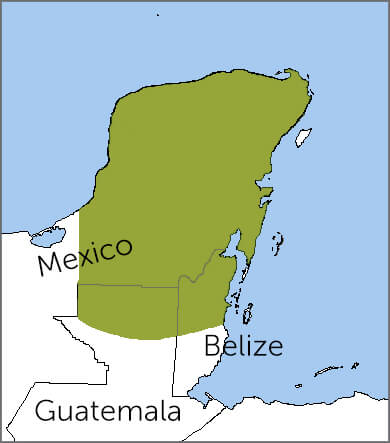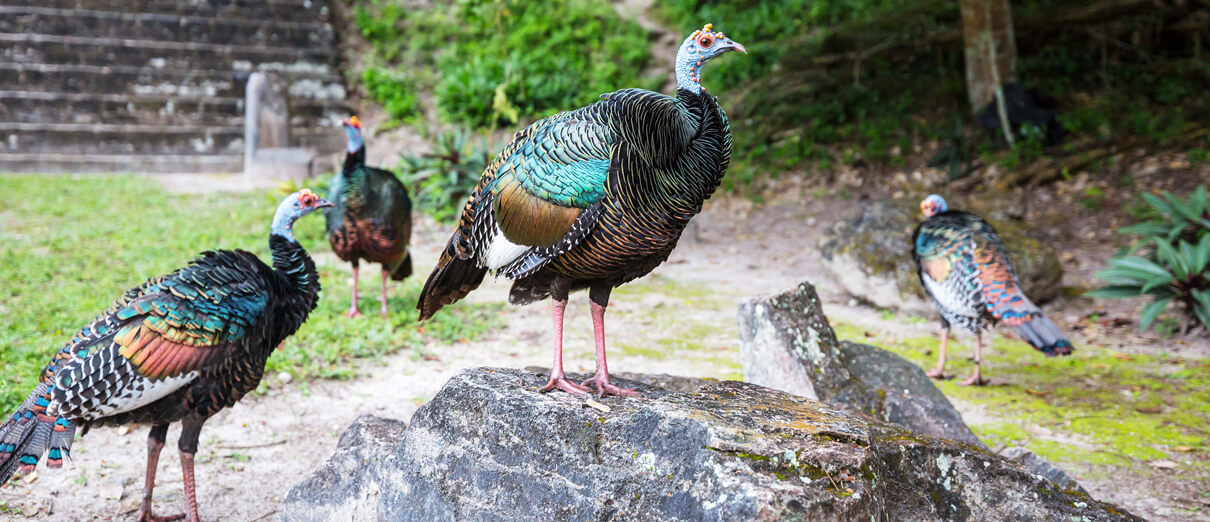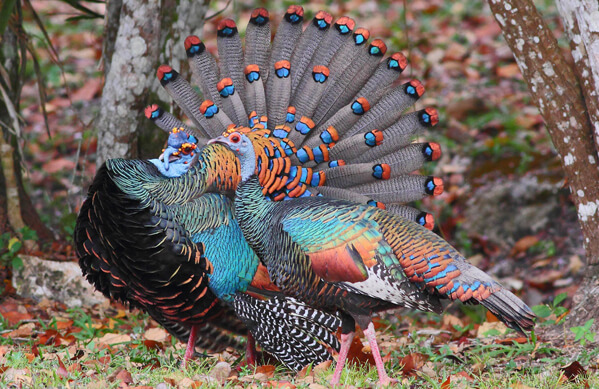
Ocellated Turkey range map by American Bird Conservancy
The Ocellated Turkey is the gaudier tropical cousin of the world's only other turkey species, our familiar Thanksgiving bird. Watching a strutting male display is like seeing a Wild Turkey through a colorized filter: The baby-blue head is dotted with red and orange wart-like bumps. Metallic body feathers shimmer in colors from electric blue to green, growing more vivid on wings also banded with bronzy-orange and white. Its striking tail recalls the peacock's famous plumes. (In Spanish, this bird is sometimes called pavo real, a term both for peacock and “royal turkey.”)
Unlike its northern relative, the Ocellated Turkey does not have a broad range. It's only found on the Yucatán Peninsula, which embraces a few Mexican states, the northern half of Belize, and Guatemala's northern Petén region. Despite its size and eye-popping plumage, this bird lurks mostly unseen amid thick foliage, like other turkey-like birds such as the Great Curassow. The peninsula's remaining forests also support a number of wild cat species. What does the Ocellated Turkey have in common with one of these slinky felines?
Spotting Similarities
Particularly within large expanses of undisturbed habitat, the Ocellated Turkey must keep a wary eye out for wild cats, including the Jaguar, Puma, Jaguarundi, Margay, and the Ocelot, with which the bird shares part of its name. The word “ocellated” derives from Latin for “having eye-like markings.” In the turkey's case, this refers to rows of large metallic-blue and orange spots on its tail feathers. The same root occurs in the name Ocelot, referring to the outsized, two-toned spots adorning this cat's fur.
Both the Ocellated Turkey and the Ocelot, unfortunately, have something else in common: Both are declining and face heavy hunting pressure and habitat loss in most of their range.
Masters of Pomp
Ocellated Turkeys breed starting in March. A displaying male strides through a group of females, his tail spread wide and his head tilted back, resting on his fluffed back feathers. Wings shaking and occasionally rapped on the ground, he suddenly bursts into a rapid series of gobbles shallower than his larger relative — sounding like a barnyard goose trying to imitate a turkey. A dominant male may mate with many females, thwarting attempts by other males to mate with them.
Listen here:
(Audio: Paul Driver, XC522868. Accessible at www.xeno-canto.org/522868.)
Nesting occurs starting in April. The hen lays eight to 15 eggs in a scrape on the ground, then incubates the clutch for four weeks. Young are precocial, meaning that they can scamper off as soon as they hatch. The chicks stay with the hen until the start of the next breeding season.
Reverence and Ruins
The ancient Mayans revered turkeys. They considered them powerful and valued their iridescent feathers and impressive leg spurs. They traded for Wild Turkeys from the north, which they domesticated. But they also greatly appreciated the local Ocellated Turkeys living in forests just outside their settlements. Both species were eaten, sacrificed, and worshiped. On his epithet, a Mayan leader was even honored as Chak Ak'ach Yuhk, translated by archaeologists to mean “Great Male Turkey, Shaker of Cities.”
The Ocellated Turkey is still an iconic species of the Yucatán Peninsula's tropical forests, including around major Mayan ruin sites such as Guatemala's world-famous Tikal National Park.

Ocellated Turkeys at Tikal, Guatemala by Galyna Andrushko/Shutterstock
Grounded Diet
Ocellated Turkeys usually forage under thick cover within forest and scrub-forest, but will venture into clearings and adjacent farm fields for waste corn and other feeding opportunities. They spend much of their time seeking seeds, fruits, leaves, and insects and other small creatures.
Hunt for Solutions
The International Union for Conservation of Nature (IUCN) ranks the Ocellated Turkey as Near Threatened because many populations are in decline due to uncontrolled subsistence hunting and continued habitat loss. Healthy populations are protected in Guatemala's Tikal, in private and national reserves in Belize, and in some large Mexican reserves.
In some areas, traveling sport hunters buy permits and hire guides to hunt Ocellated Turkeys, providing an economic boost for outfitters, guides, and farmers. Recent research shows promise for carefully managed hunting of Ocellated Turkeys in ejidos, or community-run lands, in Mexico. There, some communities report increasing turkey populations kept in balance by a mixture of conservation, cultivation, and sustainable game management. The Wild Turkey's rebound in the U.S. was fueled by a similar melding of conservation, agriculture, and forestry.
Habitat loss remains one of the greatest threats to the Yucatán's wildlife, including the Ocellated Turkey and other endemic species like the Yellow-lored Amazon and Yucatán Poorwill, as well as wintering Neotropical migrants including the Kentucky Warbler, Wood Thrush, and Ovenbird.
ABC works with partners to conserve birds throughout the Americas, in reserves and on working lands, often on a landscape scale through our BirdScapes approach.
Donate to support ABC's conservation mission!



















































